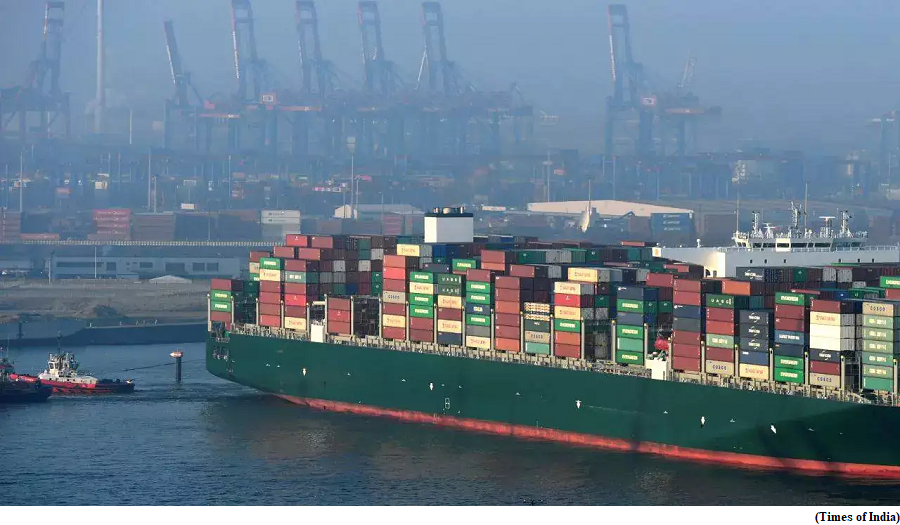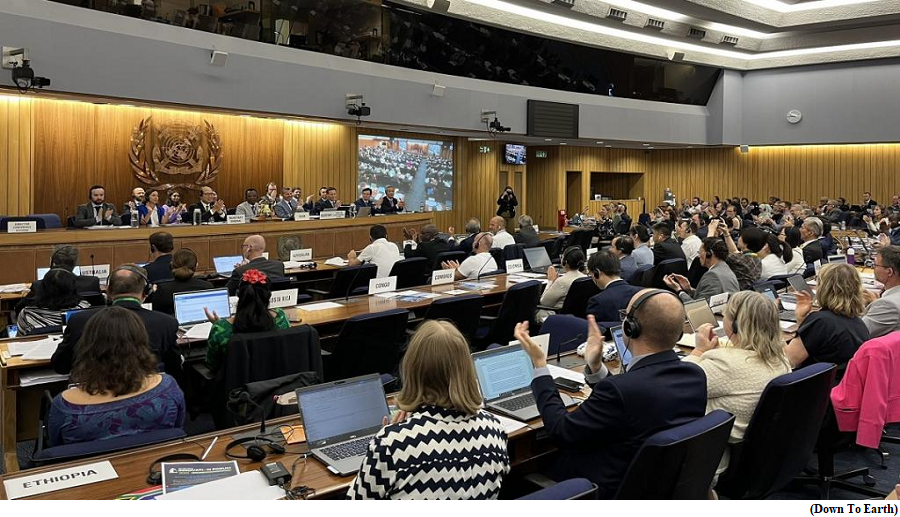India best performing in South Asia in terms of trade facilitation, UNESCAP (GS Paper 2, International Organisation)

Why in news?
- Recently, the United Nations Economic and Social Commission for Asia Pacific's (UNESCAP) Global Survey on Digital and Sustainable Trade Facilitation was released.
- The 2023 survey, covered more than 140 economies evaluating 60 trade facilitation measures.
Key Highlights:
- It has positioned India at the forefront of global trade facilitation efforts, with an impressive score of 93.55% in 2023 vis a vis 90.32% in 2021.
- It recognized India's exceptional progress across various sub indicators, with the country achieving a perfect score of 100% in four key areas: Transparency, Formalities, Institutional Arrangement and Cooperation, and Paperless Trade.
- It is testament to India's relentless efforts in streamlining trade processes, enhancing transparency, and promoting cooperation among stakeholders through initiative such as Turant Customs, Single Window Interface for Facilitation of Trade (SWIFT), Pre-Arrival data processing, e- Sanchit, Coordinated Border Management etc.
- India has witnessed a substantial improvement in the score for “Women in Trade Facilitation” component from 66.7% in 2021 to 77.8% in 2023 thereby indicating commitment to gender inclusivity and the empowerment of women in the trade sector.
- India is now the best performing country amongst all the countries of South Asia region. The overall score of India has been greater than many developed countries including Canada, France, UK, Germany etc.
About Global Survey on Digital and Sustainable Trade Facilitation:
- The Global Survey on Digital and Sustainable Trade Facilitation conducted by UNESCAP covers WTO Trade Facilitation Agreement (TFA) along with set of nearly 60 trade facilitation measures categorized into eleven sub-groups, namely: Transparency; Formalities; Institutional arrangement and cooperation; Transit facilitation; Paperless trade; Cross-border paperless trade; Trade facilitation for SMEs; Agricultural trade facilitation; Women in trade facilitation; Trade finance for trade facilitation; and Trade facilitation in times of crisis.
- The survey is fact-based rather than perception-based. A three-step approach to data collection and validation is generally followed, implemented over 6-month period every 2 years.
- The Survey reflects the efficacy of Trade facilitation measures taken by Indian Customs such as Turant Customs comprising of Faceless Customs, Paperless Customs and Contact less Customs, in enhancing India's ease of doing Business and promote trade facilitative environment in the country.
United Nations IMO agrees to reach net zero “by or around” 2050
(GS Paper 3, Environment)
Why in news?
- Recently, the 2023 IMO Greenhouse Gas Strategy was adopted at the conclusion of the summit of the United Nations International Maritime Organization (IMO) in London.
- The Maritime countries upgraded their Greenhouse House Gas (GHG) emissions strategy to reach net zero “by or around” 2050 without specifying a definite year and taking into account different national circumstances.

Key Highlights:
- The draft document says to peak GHG emissions from international shipping “as soon as possible.” This is to limit the global temperature increase to well below 2 degrees Celsius as outlined in the 2015 Paris Agreement, the international treaty on climate change.
- It calls for the international shipping industry “to reduce the total annual GHG emissions from international shipping by at least 20%, striving for 30%, by 2030, compared to 2008.”
- It also urged the industry “to reduce the total annual GHG emissions from international shipping by at least 70%, striving for 80%, by 2040, compared to 2008.”
- It said near-zero emission technologies, fuels, and energy sources should “represent at least 5%, striving for 10%, of the energy used by international shipping by 2030.”
Biofuels:
- The IMO adopted an interim guidance which said that internationally certified biofuel and bio-blends can be used in the shipping industry. This resolution was backed aggressively by India at the conference.
- The revised strategy also says that the carbon intensity of international shipping should decline to reduce CO2 emissions “per transport work”, on average by at least 40 per cent by 2030, compared to 2008 baseline levels.
Emissions by maritime shipping:
- According to the Intergovernmental Panel on Climate Change 2022 report, maritime shipping is responsible for three per cent of global anthropogenic GHG emissions and these emissions are continuing to grow rapidly.
- The IMO’s own estimates in 2020 say that a business-as-usual scenario would see shipping emissions increase more than five-fold by 2050 if the shipping industry fails to act now.
ISRO Chandrayaan 3 mission and its potential to boost Indian economy
(GS Paper 3, Science and Technology)
Why in news?
- The Indian Space Research Organisation (ISRO) is gearing up for the launch of its ambitious Chandrayaan-3 mission on July 14. This upcoming lunar exploration mission holds significant promise for the Indian economy.

India’s space tech rush:
- India's latest space mission is a testament to the country's remarkable progress in space exploration and technology.
- Just a couple of years ago, India’s space economy was valued at over $9.6 billion in 2020. By 2025, this could go up to $13 billion, according to EY India.
- At present, the country has over 140 registered space-tech startups, including Skyroot, SatSure, Dhruva Space, and Bellatrix, who are working towards creating technologies that have real-world utilities – from satellite-based phone signals, broadband, OTT, and 5G to the operation of solar farms and much more.
- Venture capitalists are increasingly seeing India's space-tech sector as a lucrative opportunity, given the scale of the market and the sector's historic achievements in 2022. The year was marked by many firsts, including a private rocket launch and multiple other satellite launches.
- Greater private participation in India’s space industry with the approval of the Indian Space Policy 2023 is likely to provide a bigger boost to the Indian space-tech ecosystem in 2023.
- Initiatives like the Indian National Space Promotion and Authorization Centre (IN-SPACe) have already promoted private participation in space activities.
Chandrayaan-3's success and its economic impact:
Investment boost:
- The successful launch of Chandrayaan-3 could bolster investor confidence and attract more private investment in space technology.
- It will make India the fourth country to achieve the feat, adding that it will significantly boost investments.
- It promotes the cost-efficient and highly reliable space-grade hardware that the Indian space industry has supplied for this mission, increasing revenue flow and investments into the industry. It also validates our industry to become suppliers to lunar programs by other countries.
- Moreover, increased private sector involvement can lead to the emergence of new startups, businesses, and job opportunities, further driving economic growth and innovation.
Impact on space start-ups and jobs:
- The rapid growth in India’s space-tech ecosystem has created thousands of jobs over the past few years since the pandemic but has historically struggled due to a lack of focus on the space economy. But today, the sector has the potential to create lakhs of jobs, both blue-collar and white-collar.
- In addition to jobs, the Chandrayaan-3 mission will also open up commercial opportunities for Indian companies and startups in the space sector.
- The success of the mission will add to India’s goodwill in the space league and serve as a technology demonstrator for future moon missions.
Global positioning:
- The success of the mission would position India among the top four technologically-advanced space nations and pave the way for important international collaborations, similar to the recent Artemis Accord signing between ISRO and the American space agency NASA.
- The success of the ambitious lunar mission could also position India as a potential counterweight to China in the global space race.
- Along with Russia, China offered low-cost options for launches. But with Russia reeling under economic pressure due to its conflict with Ukraine, India has a perfect opportunity to compete and strengthen its position.




